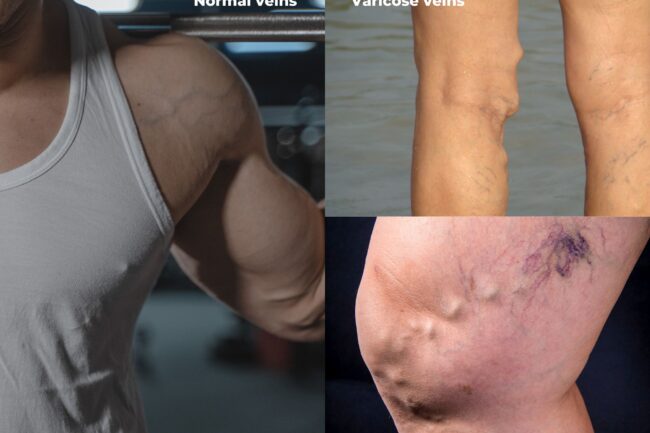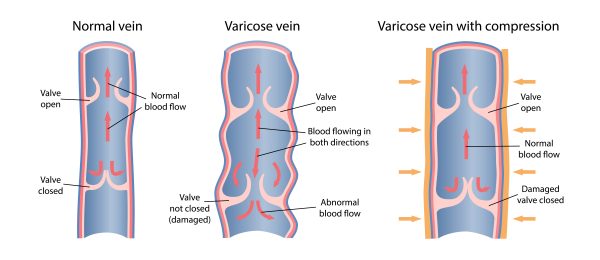Varicose veins are the most common venous issue that people can suffer from, affecting up to a third of all adults. So how do you tell the difference between a vein that is just a bit more prominent and one that is varicose and insufficient? You’ll need to look out for size, lumps, and often accompanying symptoms like itchiness, limb fatigue, and swelling.
Varicose veins vs normal veins?
Telling the difference between the two lies in understanding how they differ in function. When a vein is healthy, it brings red oxygenated blood from the heart down into the legs and blue deoxygenated blood back up to the heart again. These veins aren’t often visible unless you’re exercising when the veins pump blood to the surface of the skin to keep you cool. When they are visible, they appear below the surface without any raised bumps or edges.
When it comes to varicose veins, they tend to appear as raised or even bulging, most often a green or purple colour (this is because the blue blood mixes with the yellow of the skin pigment in the light).
While there’s a visual difference, varicose veins can also cause a range of symptoms. If the area becomes itchy, swollen or causes a hot or burning sensation, particularly at the end of the day, they’re likely varicose veins.

Internally, the most common characteristics doctors see in varicose veins are:
- The interior vein walls become less smooth, disordered, and inflamed – this means they are less able to allow blood to pass through efficiently.
- The venous valves (gates) that allow blood to flow back into the veins become dysfunctional and no longer close properly.
When left untreated, varicose veins may progress and cause inflammation of the vein walls which could lead to serious health problems. Doctors believe that inflammation plays a strong part in why the cell walls of varicose veins become disordered, chaotic, and inefficient. Slower blood flow is the most common cause of venous inflammation. So the longer the cell walls of varicose veins remain untreated, the more inflamed they become.
When to speak to your doctor
While you might have a strong suspicion that the condition is developing, no matter how keen your eyes and honed your senses, you’re only able to see the veins on the surface. Varicose veins can develop out of sight alongside the others closer to the skin. Seeing a vein expert is the best way to check all your veins, as they can do a full image scan of your legs using ultrasound technology to observe even the deepest veins in your legs.
What can I do to slow progression?
If you have spotted varicose veins in your legs, or you’ve had a specialist confirm it for you, taking the right steps to manage the issue is crucial for your vein health. While for some people, their condition may never progress past their current state, others may find the symptoms become increasingly worse, or they may even indicate a more serious underlying condition.
To keep the symptoms under control, at a minimum, you should be taking care of them at home. This includes such things as:
- Wearing compression stockings to reduce swelling and aid blood-flow, helping slow down their development.
- Exercise more regularly, particularly swimming, walking and running.
- Cut down on foods high in fat and sugar.
If the veins are causing swelling, pain, itchiness or other symptoms, it’s worth speaking to a vein doctor to look at getting them treated. With current treatments virtually pain-free and requiring no downtime, having your veins treated is a better choice than ever these days.
To sum up
Normal veins are often small and untwisted, though they may curl and branch in places. They may sometimes protrude above the skin surface during strenuous exercise, hot weather, or if you have a low amount of body fat. Varicose veins, meanwhile, are large, twisted, bulging veins that often have a green rope-like appearance. They also often cause symptoms.
Seek expert advice
The doctors at The Vein Institute specialise in varicose vein treatment. We offer patients a comprehensive program using non-surgical laser treatment techniques. To book a consultation and discuss our treatment program, call 13 VEINS (that’s 13 83467). Or, make an enquiry via the Contact Us page.
